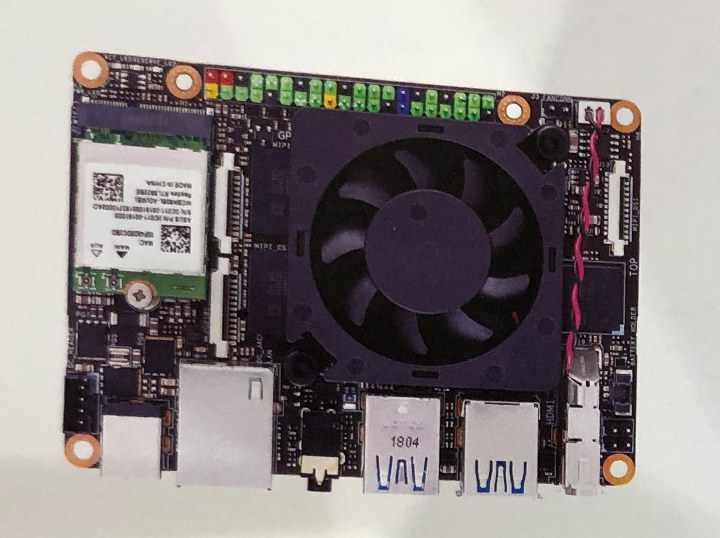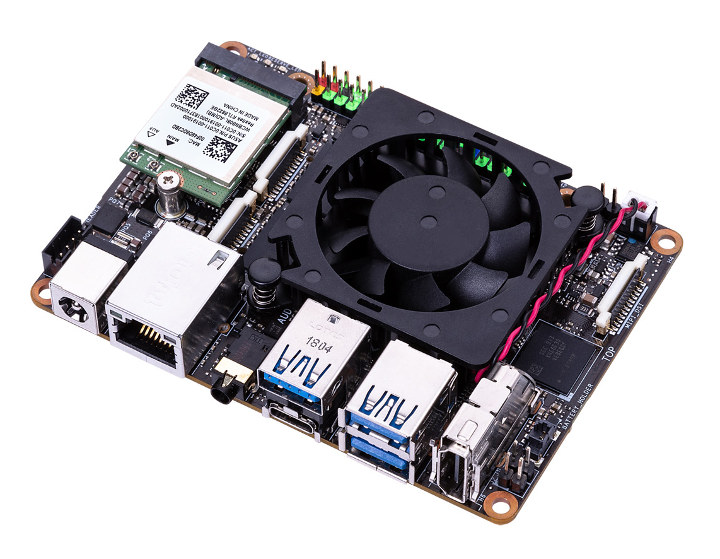Just a few days ago, we wrote about ASUS Tinker Edge T board and other products from ASUS featuring Google Coral Edge TPU which were showcased at Computex 2019. It turns out the company is working on another Tinker with a processor featuring an neural network accelerator. Meet ASUS Tinker Edge R Pico-ITX SBC powered by Rockchip RK3399Pro hexa-core processor equipped with a 3.0 TOPS NPU.

One of the reasons it did not get noticed is that ASUS may not have had a sample for display at the event, but instead only described the board in a brochure. [Update: ASUS Tinker Edge R was also showcased at Computex 2019]
ASUS Tinker Edge R SBC preliminary specifications:
- SoC – Rochchip RK3399Pro hexa-core big.LITTLE processor with 2x Cortex A72 cores up to 1.8 GHz, 4x Cortex A53 cores @ 1.4 GHz, an Arm Mali-T860 MP4 GPU up to 800 MHz with OpenGL ES 1.1 to 3.2, OpenVG1.1, OpenCL 1.2 and DX 11 support, and NPU delivering up to 3.0 TOPS
- System Memory – 4 GB dual-channel LPDDR4 memory for system, 2 GB LPDDR3 memory for NPU
- Storage – 16GB eMMC flash, micro SD card slot
- Video Output – HDMI, DisplayPort via USB-C port, up to 2x MIPI DSI connector (one MIPI connector is multiplexed with DSI or CSI available)
- Audio – 3.5mm audio jack
- Camera – Up to 2x MIPI CSI-2 connectors
- Connectivity – Gigabit Ethernet, 802.11ac WiFi 5, Bluetooth 4.2 2T2R
- USB – 3x USB 3.1 gen1 ports, 1x USB 3.1 gen 1 type-C OTG port
- Expansion
- mPCIe slot for 4G/LTE extended; nanoSIM card slot on-board
- 40-pin GPIO header with same pinout as original Tinker board with I2C, SPI, UART, PWM, I2S, and GPIOs
- Misc – RTC battery header, power-on header, header for reset button
- Power Supply – 12V to 19V input via power barrel jack or header
- Dimensions – 100 x 72mm (Pico-ITX form factor)

The board will come with fully open-source kernel and support for multiple APIs, including OpenGL, Vulkan, OpenCL, OpenVX, TensorFlow Lite, Android NN, and Caffe.
Hardware specifications are subject to changes before mass production gets underway. It’s unclear when the board will become available, and at what price, but based on pricing for Toybrick RK3399Pro board, it should be quite over $200 in this configuration.

Jean-Luc started CNX Software in 2010 as a part-time endeavor, before quitting his job as a software engineering manager, and starting to write daily news, and reviews full time later in 2011.
Support CNX Software! Donate via cryptocurrencies, become a Patron on Patreon, or purchase goods on Amazon or Aliexpress





Look at that, a standard form factor development board.
It’s just a shame it’s going to be hot and noisy.
Oh and quite expensive. But then again, the RK3399Pro is not the chip you want for a run of the mill media player anyhow, so that might not be an issue.
In target environments fans are not necessarily welcome due to reliability issues. And when it’s for developers (so that they have the same CPU to hack on), none of us supports to have a spinning fan on our desk. I think it’s a mistake they made to give up on correct cooling on such a board.
FYI, it’s impossible to cool the RK3399, let alone the RK3399Pro passively on such a small board, at least if you’re doing any kind of heavy processing on it. So it’s not about correct cooling, it’s simply not physically possible, as the SoC generates so much heat. They need to do a node shrink to get down the heat generated by the chip.
My NanoPi-M4 with its board-size heatsink keeps working without throttling at 2.1 GHz (A72) and 1.6 GHz (A53) 24×7 and it’s slightly smaller. At 1.7 however it does throttle. It remains between 78 and 83 degrees C. So it is possible, it’s a matter of heatsink size and exchange surface with the environment. Making the heatsink touch the ground was a good idea as it also spreads into the support (the desk in my case) which happens to help keep it at reasonable temperature.
I guess at this stage it’s redundant for me to stay how RK3399 chromebooks work throttle-free entirely off heat pipes : )
Yes, because you have the surface area of the heatsink attached to the other end of the heatpipes and the heat is being removed from the CPU area. Heatpipes are a different game. None of the development boards have those afaik.
I agree that the heat-transport situation is not the same on SBCs, but then again, they mostly stay headless. Perhaps SBCs like nanoPi-m4 will turn the tide.
Fans are OK, just most used come from noise and power hungry PC target market.
Better heat extraction designs, as Blue notes below is the solution.
Try using the GPU at the same time and the board will burn out.
RockPro64 with conservative settings (1.8/1.4 GHz) and running cpuburn-a53 on all 6 CPU cores for an hour:
Still no throttling but if I would’ve allowed RK3399 to clock up to 2.0/1.5 GHz then throttling would’ve had occurred. I’m using the tall RockPro64 heatsink directly attached to RK3399 with some thermal compound in between at an ambient temp of 25°C. The RockPro64 heatsink performs better than the NanoPi M4 approach especially when using vendor’s poorly performing thermal pad on the latter: https://github.com/ThomasKaiser/Knowledge/blob/master/articles/Heatsink_Efficiency.md
So I guess it’s about the use case but I really doubt decent performance with RK3399Pro is possible with passive cooling only (at least not at that size).
I think its a shame the m.2 card is forced to be tiny. If they put the RK on the underside there would be space for a larger one and the cooling could be made much larger.
> I think its a shame the m.2 card is forced to be tiny
And two PCIe lanes not exposed due to the M.2 slot being key A or E 🙁
There have a mini pcie slot for modem module on the underside already.
There have a mini pcie on the back side.
ASUS is talking about that board again, so it should be available soon, but I have yet to see it for sale.
The version with 3GB RAM (2GB for CPU, 1GB for NPU) is available on Aliexpress for $179.